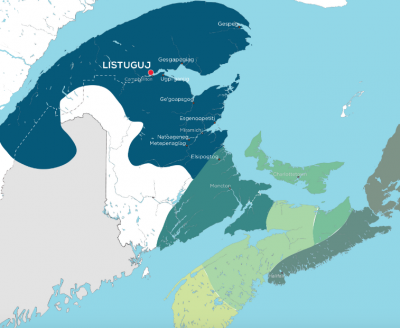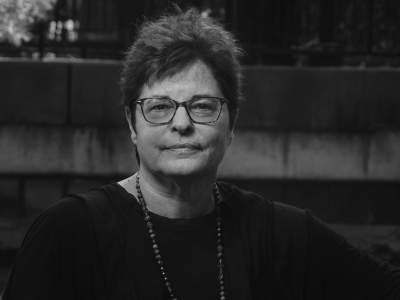By Mary Giles
Viviane Gray was the first university graduate from Listuguj First Nation. She received a BA in Anthropology from Carleton in 1973. She is an arts administrator, curator, artist and writer, as well as former director of the Indigenous Arts Centre at Crown-Indigenous Relations and Northern Affairs Canada.
In June 2016, her nephew, Darcy Gray, graduated from the first cohort of Carleton’s graduate diploma in Indigenous Policy and Administration (IPA). In the same week as his convocation, he was elected chief of Listuguj First Nation. Chief Darcy Gray was re-elected in 2018 and again recently in November 2020.

Map created from: Mi’gmawei Mawiomi Secretariat Gespe’gewa’gi Claim Map, www.migmawei.com; Mi’kmaq Spirit.
Listuguj is located north of Point-à-la-Croix, Quebec, beside the New Brunswick border. The Listugujewaq traditional territory of Gespe’gewa’gi “the last land” includes what is now known as the Gaspé Peninsula, parts of mainland Quebec and Maine, as well as northeastern New Brunswick.
“It has been difficult not to be able to hold our annual events during the COVID-19 pandemic,” says Gray. “The annual powwow in August really reminds us how important ceremony is for our well-being. We are committed to supporting one another and continuing to build community as we have done through many other crises. The important aspect to keep in mind is that we have always come away stronger.”
Before joining the IPA program, Gray worked for 15 years supporting students in the Listuguj community’s Alaqsite’w Gitpu School, then as a guidance counsellor for Listuguj students attending Sugarloaf Senior High School. He is teaching again this winter for Cape Breton University’s in-community Bachelor of Arts Community Studies program.
“We just kicked off the program in January,” he says. “I am fortunate enough to be the first instructor. We have a cohort of 20+ students, studying full-time in evenings and on weekends, working towards their BA and BBA combined. This is their first course in a long journey.”
Leadership, Management and Community Development
Since Carleton’s IPA program is part-time and online, Gray was able to continue to work full-time, live in the Listuguj community and have time for his family while completing the diploma.
The IPA program starts out in-person for two weeks in June (online in 2020 and 2021). Students have been able to visit Kitigan Zibi (an Anishnabeg Algonquin community north of Ottawa), Akwesasne (a Mohawk community bordering Ontario, Quebec and Vermont) or — virtually in 2020 — Pikwakanagan (an Anishnabeg Algonquin community on Golden Lake, Ontario).
“We were able to meet with elders and community members, take a tour and share a traditional lunch,” says Gray. “It’s important to visit other communities to learn from their experiences. At Akwesasne, we visited the college on Cornwall Island and learned about their efforts to sustain Mohawk culture and expand its governing jurisdiction.
“Learning about and learning from other communities is something that I’ve continued to do as chief,” says Gray. “The openness, sharing and welcoming approach opened doors of collaboration that I’ve been able to maintain and have proven to be very helpful. Relationships built through the IPA program are still active. This is an important part of what has set me on the path that we continue on as a community.
“The program taught me about leadership, management and community development. The knowledge and skills I learned in the IPA have helped me in my current position to work in a team, develop partnerships and collaborate with organizations in the community and beyond.”
Rebuilding First Nations Governance
Gray is a Peace and Friendship Treaties co-lead on the steering committee for the Rebuilding First Nations Governance (RFNG) project. The project is supported by a $2.5 million SSHRC Partnership Grant led by Professor Frances Abele in the School of Public Policy and Administration. RFNG is a national alliance of First Nation communities and Tribal Councils, academic researchers and public sector practitioners. The aim is to support leaders and rights holders in the transition from the Indian Act to self-governance.
Listuguj Mi’gmaq Government (LMG) is also a partner organization with the RFNG project. Gray says, “We’re focusing heavily on capacity development. We want to find ways to either maintain or build up the community to better meet our needs. We are also focused on continuing to rebuild our community according to our vision for our future.”
“In-community programs go a long way in that direction,” he says. “There’s no need to try to entice or recruit students to return home. They can be incorporated into the workforce and community development as they work through the programs.
“Students in Listuguj’s in-community Bachelor of Education program, in partnership with McGill University, were already working in our school while finishing up. With Community Studies, we’re working with Cape Breton University and many students are already working for us and looking to take on larger roles within the organization.
“The bachelor programs are very Listuguj driven. We developed handbooks to guide course plans and pedagogy. Most of the instructors are from Listuguj, so we can provide students with in-person support.”
Fishing: A Treaty Right
The community is working towards financial autonomy through strategic partnerships and the creation of new businesses, adding to already established revenue generating initiatives including forestry, chipper operations and fisheries.
The license issued to Listuguj in the fall from the Department of Fisheries and Oceans (DFO) only allows for caught lobster to be used for food, social and ceremonial purposes. In 1999, however, the Supreme Court of Canada ruled that Mi’gmaq fishers have the right to a “moderate livelihood” under the Peace and Friendship Treaties of 1760-61.
Gray says fishers are criminalized under the DFO for exercising their rights. He is pushing for a recognition of their right to earn a ‘moderate livelihood’ and to have the DFO regulations reflect the Treaty agreement.
“Despite challenges due to the pandemic and DFO’s reluctance to recognize our rights, the fall 2020 lobster fishery was a success. We fed the elders and hundreds of people in the community. We also helped our people to be able to make a living through the fishery and continue to build a greater sense of community through responsible fishery management.”
Gespe’Gewa’Gi: The Last Land is a documentary series about the Listuguj community’s fishing industry and its cultural and historical significance.
Listuguj Mi’gmaq Government
The LMG is a large, complex organization, incorporating administration, education, finance, health, social services, infrastructure and public safety.
One of Gray’s top priorities is to create financial independence for the community and its members. He says, “With close to $40 million in capital projects currently in development or ready to start this spring, there’s a lot of opportunity for direct employment and for entrepreneurs. Coupled with other initiatives centered around small grants for community businesses to encourage entrepreneurship and local tourism, there is a lot to be excited about.
“We’ve been able to continue the projects we initiated prior to or early on in the pandemic and take on more. It’s really an amazing feat that speaks to the strength and resolve of our people. We have more lined up and ready to go across all departments of the LMG. We also know that supporting our people and creating opportunities for a healthier future is important. We need to remain focused on our people as the most valuable part of our community development.”
Community Education in the Pandemic
The pandemic has created several obstacles for younger students in the Listuguj community. 110 students attend high school in Campbellton, New Brunswick, just across the Van Horne Bridge. Gray says, “When the province closed the border to non-essential travellers in March 2020, the two communities were cut off from one another. This is something the community is still continuing to adjust to.”
When he worked as a guidance counsellor, Gray says the school environment was becoming more welcoming to Listuguj students and Mi’gmaq culture. Pandemic regulations have created division between the two communities.
“The fall and winter have been tough for the region as more and more restrictions continue to be put in place,” says Gray. “The divide has widened, despite the reduction in cases and demonstrated success of the community in how it has responded to the pandemic to date.”
In October, Listuguj students were told by the provincial school system they’d have to continue their learning at home. In response, Listuguj turned their community training centre into a learning hub for the high school students.
“Learning from home wasn’t something we believed would be good for the well-being of our students,” says Gray. “It required a massive shift in resources and patience by many to make the Learning Hub happen. We’re fortunate to have the capacity to be able to provide a safe and supportive environment for our students. Our staff have been amazing.”
Monday, March 15, 2021 in Alumni Stories, FPA Voices
Share: Twitter, Facebook



